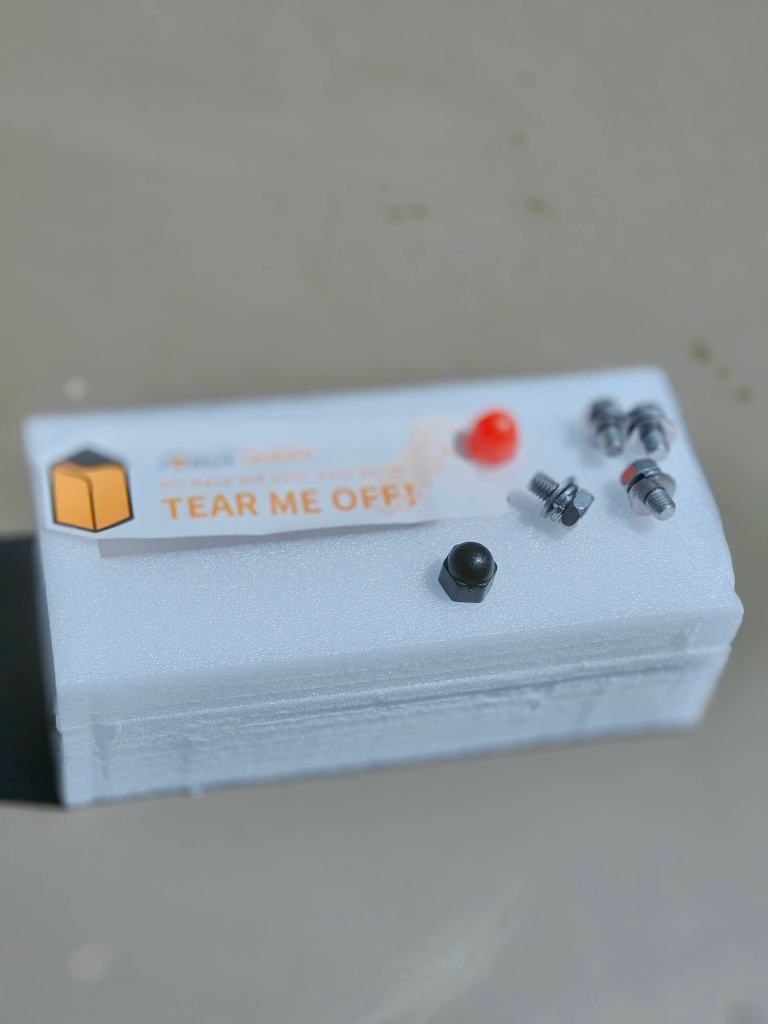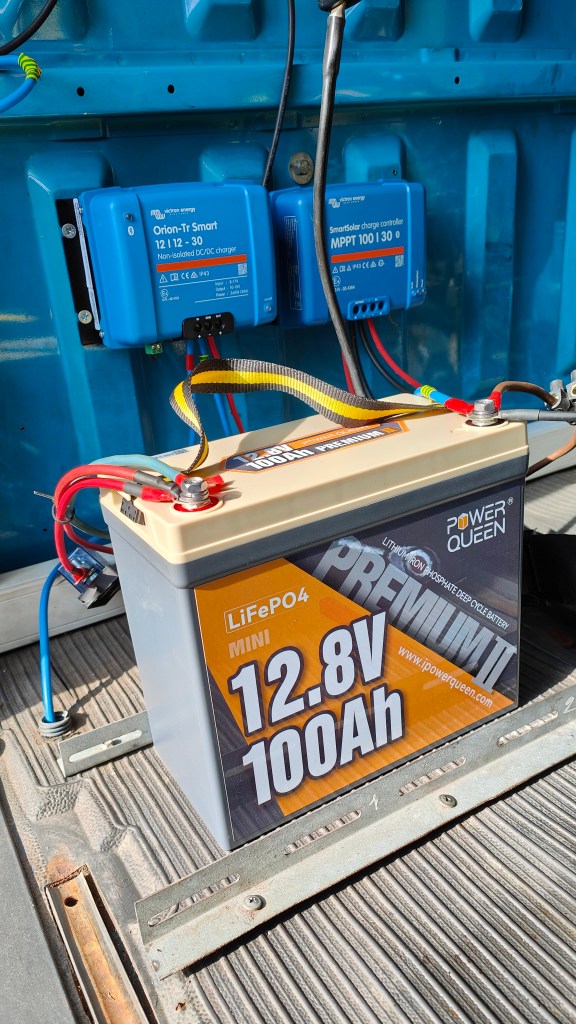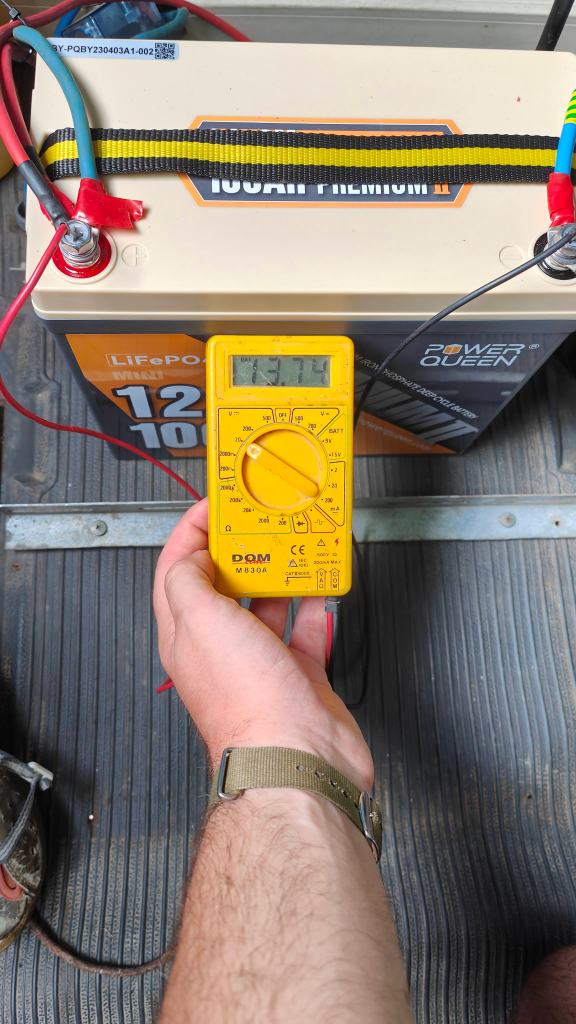We won’t hide it—we absolutely love the outdoor lifestyle. The further we are from civilization, the more alive we feel. Of course, it’s a matter of personal preference, but for us, living off-grid is the ultimate expression of freedom. 🚐💨
And guess what? That freedom relies on solar power! But as you probably know, the sun isn’t always reliable. It likes to play hide-and-seek behind the clouds or disappear completely at night. So, how can we store the energy we collect? 🌞⚡️
That’s where LiFePO4 lithium batteries come in. For us, they’ve been a game-changer for van life. A few months ago, we made the switch from two GEL batteries to a single LiFePO4 lithium battery—and we’ve never looked back.
Today, we want to talk about Power Queen, specifically the 12.8V 100Ah LiFePO4 Mini version. This brand is known for offering high-quality batteries at an incredibly competitive price.
But let’s be honest—price isn’t everything. Do Power Queen batteries really live up to their promises? Are they worth it?
We’ll break it all down for you in the next few sections.
💡 Power Queen sent us this product for review. However, this does not influence our opinion—we will share both what we love and what we don’t.
Technical Specifications of the Battery

When looking at Power Queen battery reviews, one thing stands out—the brand uses lithium iron phosphate (LiFePO4) cells in most of its batteries. While LiFePO4 batteries are heavier than standard lithium ones, they offer superior durability and a much longer cycle life, making them a solid choice for off-grid power needs.
Key Features
| Nominal Voltage | 12.8V |
| Charging Voltage | 14.4±0.2V |
| Nominal Capacity | 100Ah |
| Usable Capacity | 100Ah |
| Energy | 1280Wh |
| Maximum Continuous Charging Power | 1280W |
| Maximum Continuous Discharge Current | 100A |
| Peak Discharge Current (5 seconds) | 280A |
| BMS (Battery Management System) | 100A |
| Dimensions | 26 × 13.3 × 22.7 cm |
| Weight: | 8.96 kg |
| Discharge Temperature Range | -20°C to 60°C |
| Storage Temperature | Not specified |
The Power Queen 12.8V 100Ah LiFePO4 Mini battery boasts several notable features:
- Lightweight: Approximately half the weight of traditional lead-acid batteries.
- 5-Year Warranty: Providing extended peace of mind.
- Modular Design: Supports both parallel and series connections for flexible configurations.
- 100A Battery Management System (BMS): Ensures efficient and safe operation.
- Extended Lifespan: Claims of up to 15,000 cycles under specific conditions.
Regarding the lifespan, while Power Queen advertises up to 15,000 cycles at 60% depth of discharge (DoD), it’s important to approach this claim with some caution. Typically, LiFePO4 batteries offer up to 4,000 cycles. Therefore, real-world performance may vary, and we’ll monitor and update our findings over time.
According to their specifications:
- 4,000 cycles at 100% DoD
- 6,000 cycles at 80% DoD
- 15,000 cycles at 60% DoD
As for the warranty, it’s valid as long as the company remains operational. Power Queen is a relatively young company, which might raise concerns. However, based on our research and customer feedback, they have established a positive reputation in the market.
In summary, while the Power Queen 12.8V 100Ah LiFePO4 Mini battery offers impressive features and competitive pricing, it’s essential to consider the company’s longevity and real-world performance when evaluating its suitability for your needs.
Power Queen 12.8V 100Ah LiFePO4 battery: first impressions
Step 1: Unboxing



💡 The battery arrived after 7 days. However, the tracking system didn’t work for us, making it difficult to plan our van travels during that time. That being said, it seems the issue wasn’t directly related to Power Queen. Still, we felt it was worth mentioning.
Upon receiving the package, we grabbed our trusty unboxing knife to check out what was inside.
As you can see in the photo above, the first thing that caught our eye was the user manual. There are two versions—one in English and one in German—both neatly packed inside a plastic pouch.
Inside this pouch, you’ll also find a quick installation guide and some cool stickers. 😉
Beneath the pouch, the battery is carefully secured in a protective polystyrene foam casing. For extra safety, the battery itself is wrapped in plastic.

On one of the polystyrene protectors, you’ll find a small sticker that says « Tear me off. » Once removed, it reveals four M8 terminals for connecting your battery lugs.
However, having four terminals instead of two doesn’t provide much added value. If Power Queen wanted to include a useful extra, a small wrench for tightening and loosening the terminals would have been a better choice—some brands already offer this, and it makes installation easier.

Step 2: Material analysis and design of the Power Queen 12.8V 100Ah LiFePO4 battery
Despite its competitive price and glossy plastic casing, the Power Queen 12.8V 100Ah LiFePO4 battery makes no compromises when it comes to design. Its aesthetics align perfectly with its performance. The finish and texture give it a modern yet sturdy look, making it an attractive option for van life.
One standout feature is the carrying strap—comfortable, solid, and well-designed, it makes handling the battery much easier. No more worries about accidentally dropping this valuable power source! Unfortunately, we can’t say the same for some other brands we’ve tested.
The terminals are color-coded red for positive and black for negative, a small but crucial safety feature that often goes unnoticed.
At 8.96 kg, the weight is quite reasonable for a 1,280Wh capacity. Power Queen has found the perfect balance between energy storage and portability, making it an ideal travel companion for van life adventures.
Lastly, Power Queen has really impressed us with its size optimization. The model we received is a compact version of their standard battery—a mini format that retains the same 100Ah capacity. This was achieved through:
- Optimized cell arrangement
- Improved energy density
- Reduction of unnecessary component bulk
As a result, we get a smaller battery with the same power capacity. Below, you’ll find a comparison with another 100Ah lithium battery:

What can the Power Queen 12.8V 100Ah LiFePO4 battery power?
The Power Queen 12.8V 100Ah LiFePO4 battery is a true energy powerhouse, capable of running multiple devices at once. With a continuous discharge current of 100A, it can handle a total power output of up to 1280W. And if needed, it can even deliver a peak current of 280A for 5 seconds—pure power at your fingertips!
To be honest, we rarely need to draw 1280W all at once. But if you have a hairdryer, blender, or other high-consumption device, this battery can handle it. 😉
Thanks to its efficient energy management, the Power Queen provides a usable capacity of 100Ah, translating to 1280Wh of stored energy—more than enough for extended adventures.
Laptops, fridges, LED lights, smartphones… the list goes on!
That being said, while this battery supports 100% discharge, we recommend keeping it within 70-80% depth of discharge to extend its lifespan. This still gives you a solid 80Ah of usable energy for daily use!
[TEST] Practical application of the Power Queen 12.8V 100Ah LiFePO4 battery
1. Planning electricity and energy needs
Before investing in a 100Ah lithium battery, it’s essential to assess your daily energy consumption.
The calculation is quite simple: just list all the electrical devices you use in your van, RV, or off-grid home. For each device, estimate its power consumption in watts, how many of them you use, and the number of hours per day they run.
To make things easier, we recommend using our electrical simulator, which includes a built-in energy consumption calculator. Simply click on the screenshot below 👇 to access it!

This calculator will provide you with your daily energy consumption in both Ah (amp-hours) and Wh (watt-hours). This information is essential for determining the battery capacity you need.
In our case, our daily energy consumption is around 750Wh (more precisely, 719Wh). A 100Ah battery is sufficient for our setup, while also allowing for a safety margin.
Additionally, we prefer to avoid discharging the battery to 100%, ensuring a longer lifespan and better efficiency over time.
Verifying the actual energy capacity of the Power Queen 12.8V 100Ah LiFePO4 battery
When living in a van or using off-grid equipment, every watt counts. We need a reliable battery to power our essential devices—whether for work, cooking, or simply relaxing.
That’s why it’s crucial to verify the actual capacity of our battery. On paper, the specifications always look great, but how does it perform in real-world conditions?
Since every battery is different, the only way to confirm its true performance is through a capacity test.
So, let’s find out if this Power Queen battery truly delivers on its promises.
Capacity test
To carry out this test, we used the following equipment:
- A 385W solar panel with a Victron charge controller
- Our 500W inverter
- A power meter to measure energy consumption
- Various devices to discharge the battery
This setup allowed us to accurately assess the real capacity and performance of the Power Queen 12.8V 100Ah LiFePO4 battery.
Step 1: Preparing the test
Before starting, we made sure that the Power Queen 12.8V 100Ah LiFePO4 battery was fully charged. To obtain accurate test results, it’s essential to begin with the battery at 100% capacity.
We used our MPPT charge controller, which was connected to our 385W solar panel. However, you could achieve the same result using a mains-powered charger.


The charging process was fairly quick, taking just under 5 hours. During this time, our solar input averaged around 215W, with a peak at 283W, as shown in the screenshot above.
Step 2: Setting up the test equipment
Next, we connected the battery to the entire electrical system of our van, including our 500W 12V-to-220V inverter.
Once everything was set up, we began our test by powering various everyday devices typically used in van life. To simulate a high-demand workday, we ran a mix of electronic devices to mimic real-world usage.
Importantly, we disconnected the solar panel to ensure that the battery was not recharging during the test, allowing us to measure its true discharge capacity.
Step 3: 100% battery discharge

We started by turning on our two laptops, each consuming 65W, for a total workday of 10 hours, but with only two 1-hour recharges each. This intensive usage simulated a typical digital nomad workday in a van. This alone consumed:
65W * 2 recharges * 1.5h * 2 people = 390Wh.
Next, we charged two smartphones: one consuming 80W and the other 22W. Assuming each phone charged for 2 hours, this added:
80W * 2h + 22W * 2h = 204Wh.
We also lit up our living space using our 10W lamps. For the test, we kept them on all day—even when we were out shopping! From 8 AM to midnight, this added:
150Wh to our total consumption.
Additionally, we charged a Kindle e-reader, which consumes about 15W for 2 hours, adding:
30Wh.
Finally, we charged a drone using a 50W charger for about 1.5 hours, adding:
75Wh.
At the end of the first day, our total consumption was:
390Wh + 204Wh + 150Wh + 30Wh + 75Wh = 849Wh.
We repeated the same usage the next day, but this time only with the laptops and lamps. When our battery finally stopped powering our devices, our total recorded consumption was close to 1210Wh.
Step 4: Monitoring the temperature
At the same time, we carefully monitored the battery temperature to ensure it stayed within safe operating limits. Fortunately, despite the extended periods of use, the temperature never exceeded 40°C, which is well below the upper limit of 60°C.
Capacity test results
Over the course of a week of testing this battery, we conducted multiple charge and discharge cycles. Overall, our results remained consistent:
The actual capacity of the Power Queen 12.8V 100Ah LiFePO4 battery ranged between 1205Wh and 1220Wh. This represents approximately 95% of the manufacturer’s claimed 1280Wh, which is a very solid performance and aligns well with expectations for real-world usage.
The Power Queen battery has demonstrated excellent performance.
It met our expectations brilliantly, powering all our devices effortlessly, even during extended use, without overheating. If you’re looking for a reliable and long-lasting battery for van life, the Power Queen 12.8V 100Ah LiFePO4 appears to be a solid choice you won’t regret.
That being said, every use case is unique, and specific conditions can impact battery performance. We always recommend conducting your own tests to get a clear idea of what to expect based on your personal setup and energy needs.
Expandability

The flexibility of a battery can be assessed by its ability to connect with other batteries in parallel or series, allowing users to expand their overall energy capacity. The good news is that the Power Queen 12.8V 100Ah LiFePO4 battery supports exactly this feature.
In simple terms:
- Parallel connection increases the total capacity (Ah) of your system.
- Series connection increases the total voltage (V).
Theoretically, you can connect up to 16 identical batteries together, significantly expanding your power storage capabilities.
Fully autonomous setup: Power Queen in a camper van
One of the greatest advantages of van life is the ability to have a fully autonomous power system, providing unmatched freedom and self-sufficiency on the road. In our case, the Power Queen 12.8V 100Ah LiFePO4 battery has proven to be a key component of our off-grid electrical setup in our camper van.
According to Power Queen’s recommendations, a solar panel of at least 300W is ideal for charging this battery. In our setup, we use a 385W solar panel connected to a Victron Energy MPPT 100/30 charge controller.
This MPPT (Maximum Power Point Tracker) technology ensures the most efficient conversion of solar energy, optimizing power flow to the battery.
For our needs, this system is more than sufficient. As demonstrated in our capacity test, we can easily last over 30 hours without recharging, even under high power consumption scenarios.
Here are our Victron Energy app settings for optimal performance:

Power Queen battery reviews: What we like and what we don’t like
👍 What we like
1. Great capacity for the price
The Power Queen is currently priced under 300€. You can check the actual price here. For the quality you get, it’s a fantastic deal.
That said, this is our perspective. It ultimately depends on how you intend to use your camper van. However, if your van is for extended vacations or even full-time living, we highly recommend taking the plunge.
On the other hand, if you use your van for occasional trips, we suggest considering GEL or AGM batteries instead.
2. Very lightweight compared to lead-acid batteries
Before this battery, we had a Creabest lithium battery, which was significantly heavier. And before that, we had a GEL battery that was much heavier (at least twice as much).
Switching to a lithium battery instead of a lead-acid one provides both a space-saving and a weight-saving advantage.
3. LiFePO4
While Li-ion batteries are excellent, LiFePO4 batteries are even better.
Batteries that use this technology are:
- Safer
- Last longer in terms of life cycles
- Retain their charge a bit longer than standard lithium batteries
Granted, they are two to three times more expensive than GEL or AGM batteries. But over time, they will save you a lot of money.
👎 What we don’t like
1. Absence of power button
The most notable downside is the lack of a power button on this specific model. This means you can’t turn off the battery when it’s not in use or when you need to perform maintenance tasks.
It’s a small detail, but it can be quite inconvenient in certain situations.
Frequently Asked Questions (FAQ) 🤔💡
We know this is a big question for you. From our experience, the answer is a big YES! This battery not only has excellent capacity, but also incredible durability. You might find other brands with higher performance, but let’s be honest, the price-to-quality ratio is quite impressive. 🎉💸
PowerQueen offers a 5-year warranty on this battery. But remember, the warranty is only valid as long as the company exists. So, let’s hope PowerQueen is here to stay for a long time! 🤞🔋
With the included quick installation guide, you should have no issues setting it up. However, it depends on your current setup. If you have a solar installation, make sure to follow the correct wiring order:
1. Charge controller to battery
2. Charge controller to solar panel
And for the disconnection order:
1. Solar panel to charge controller
2. Battery to charge controller
To be honest, we were quite impressed by the build quality of this battery. Despite its competitive price, there’s no compromise on the construction. It’s robust, looks modern, and comes with a super handy carrying strap.
This battery can power a variety of common electronics used in a van, such as refrigerators, lights, phone chargers, and more. As for being fully autonomous, yes, you can achieve complete independence with this battery! But it depends on your consumption.
For us, it’s more than enough. We mainly need to charge phones, laptops, e-readers, cameras, and a drone. We also have two LED lamps and a router that draw power from our battery. That’s it. 😀
To get started, feel free to use our electrical simulator to estimate your needs!
Conclusion: We tested the Power Queen 100Ah lithium battery
And there you have it, you now know everything about the Power Queen 12.8V 100Ah LiFePO4 battery!
Overall, this battery is an excellent choice if you’re looking for a deep cycle battery for any kind of use. The battery’s capacity efficiency and power output worked as expected, with an average of 1210Wh instead of the claimed 1280Wh.
See you soon on the road,
Johanna and Gabriel







0 commentaires